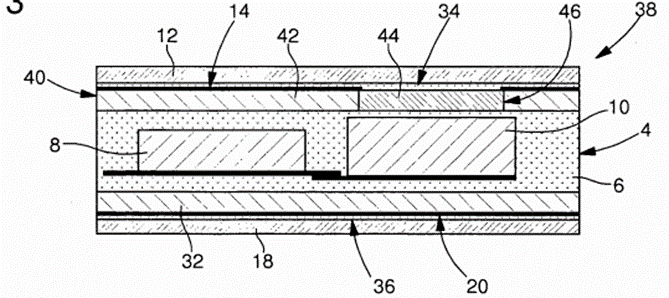The patent relates to a card with a digital display (10) comprising inter alia a “transparent” insert (44) as well as an “opaque” plastic layer (40) recovering the remainder of the card.

The present post is part of a series of three posts dealing with different aspects in opposition.
Brief outline of the case
Both opponents appealed the decision of maintenance in amended form according to a MR. Opponent 2 later withdrew its appeal.
Opponent 1 considered that the MR was not in conformity with R 80.
Opponent 1 also elaborated on the objection raised during the opposition against the amendments to claim 1 and relating to the clarity problems.
Opponent 1 also contended that the requirements of Art 83 and 123(2) as well as Art 54 and 56 were not fulfilled.
In reply to the board’s communication under Art 15(1) RPBA20 the proprietor filed a new MR.
Opponent 1 considered that the new MR should not be admitted. They also represented an amendment of the proprietor’s case which is not admissible at a late stage of the appeal procedure.
The board considered that the claims filed in reply to its communication were admissible and allowable.
The board decided remittal to the OD with the order to maintain the patent on the basis of the last MR completed by a description and the figures to be adapted, if necessary.
In the present post we will deal with the objections under R 80.
The objection under R 80
The opponent’s objection
Opponent 1 objected that moving a specific feature from the preamble to the characterising part of claim 1 of the MR would not meet a ground for opposition. This applies as well to the MR before the OD than before the board.
The OD’s position
The OD accepted the arguments of the proprietor that the amendment to claim 1 provided a better delineation of the proprietor’s position vis-à-vis E10 and thus facilitated the formulation of the proprietor’s problem-solution analysis. The OD concluded that the MR in front of it met the requirements of R 80.
The board’s position
For the board the facts related by Opponent 1 concerning the displacement of a technical feature are misleading insofar as they refer, not to the claim as granted, but to an already amended version of it.
R 80 allows amendments to parts of a European patent to the extent that they are “made in order to meet a ground of opposition“. In this case, claim 1 according to the MR upheld by the OD has been amended from claim 1 of the patent as granted in that it incorporates the features of dependent claim 8 as granted.
The board held that compliance with the requirements of R 80 to be assessed in relation to the claims as granted and not in relation to a set of claims which have already been amended.
Comments
The board considered that it has not to elucidate upon the extent to which the concern for consistency between the argumentation to demonstrate an inventive step and the two-part form of the claim justifies, within the meaning of R 80, moving a technical feature from the preamble to the characterising part of a claim.
It is however difficult to consider that moving a feature from the preamble to the characteristic portion of the claim is, when the claim is not further amended, answering a ground of opposition as the scope of the claim then remains unchanged. That it can facilitate the formulation of the proprietor’s problem-solution analysis does not appear relevant.
The decision is however interesting as it specifies that, in principle, R 80 only applies when a granted independent claim is first amended. Any further amendments of claim answering the requirements of R 80 cannot be challenged under the same rule.
R 80 can thus be considered as a kind of one-shot gun applying only to the claims as granted. If granted amended claims are abiding by the requirements of R 80, any subsequent amendment cannot be challenged under R 80.
https://www.epo.org/law-practice/case-law-appeals/recent/t170273fu1.html
Comments
Leave a comment